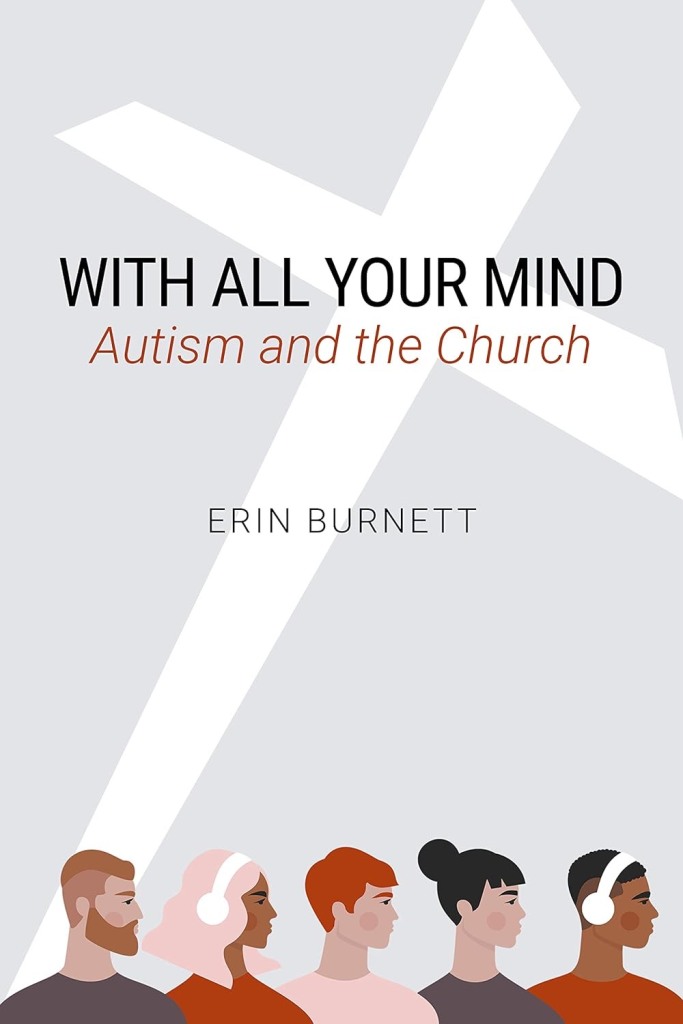
by Brandon Beck
“Love the Lord your God with all your heart, and with all your soul, and with all your mind, and with all your strength” (Mark 12:30-31)…raises some interesting questions with regards to autism: how can you love God “with all your mind” when your mind works differently? (p. 41)
At St. Mark’s Episcopal Church in San Marcos, TX, in the Diocese of West Texas I experience our church community in what, I hope, is the way Erin Burnett has experienced church. We, as a church family, too, pray that other autistic people and neurospicy families can experience church community as we do. We have many children and adults on the autism spectrum, and, when the gestalt-processing, echolalic, 8-year-old shouts, “The Blood of Christ. The Cup of Salvation,” and runs to the Communion rail clapping his hands, all of us, the St. Mark’s family, smile and celebrate with him, knowing all are welcome here. In a classroom at the back of the Sanctuary building, St. Mark’s Director of Family Ministry has created a Sensory Space with sensory play toys and books and a calm zone with the service streamed to a TV, so all the families in the church know that those with differing sensory needs, members and guests, young and old, can attend church in a way that is comfortable and accessible for them. My experience as part of this neurodivergent-aware church led me to Erin Burnett’s 2022 With All Your Mind: Autism and the Church.
Burnett’s “booklet” (p. 1) is invaluable to churches wanting to be places for all people. Burnett says, “It is very difficult to precisely define autism, as it is a spectrum condition that manifests differently for each person” (p. 1). She shares basics of autism in Chapter 1, such as characteristics of autism, autism statistics, use of language around autism, and some autistic role models. Each chapter ends with reflection questions to assist you in further relating to the content.
Chapter 2, “Autism and the Church,” brings us to Burnett’s own context of being autistic and Christian in the UK. Her story is applicable to all Christians who want to understand the role of inviting, welcoming, and connecting autistic persons to church in full communion. Burnett says, “Churches should follow the example of Jesus, who reached out to those who were ostracised from society” (p. 19). Burnett exegetes 1 Corinthians 12:14-27 and Luke 14:15-24, concluding that “Jesus takes inclusivity very seriously!” (p. 24) She moves into practical advice for churches based on a research project she conducted in which she asked, “What sorts of adjustments can make churches more welcoming for autistic people?” (p. 25) Participants most popularly suggested that churches, especially those with loud and/or contemporary worship, provide earplugs or noise-canceling headphones.
Chapter 3 and Chapter 4 focus on theology and spirituality. In Chapter 3, “Autism and God,” and Chapter 4, “The Spirituality of Autism,” Burnett explores “how autistic people may experience the Christian faith in a way that differs from the norm” (p. 31). Burnett reviews articles from Psychology Today and The Cognitive Science Society that reveal a link between autism and atheism. She expounds on the articles saying, “Autistic people are less likely to experience sensus divinitatus, the inexplicable feeling of God’s presence” (p. 32), bringing her own research and experience into conjunction with the research she reviews to demonstrate that it is not so much that atheism and autism must go together but that church must reach people with autism in different ways because of their possible missing sensus divinitatus experience.
Remembering that Burnett began by sharing that autism manifests differently for each person, we know that she is not saying here that no autistic lacks sensus divinitatus, rather that some autistic persons might experience God in ways other than what would be described as supernatural. Burnett cites John Shelby Spong’s now infamous Tweet: “God is not a noun that demands to be defined, God is a verb that invites us to live, to love, and to be” (p. 34). She says that Spong’s view of God is encouragement for autistic Christians to embrace their different ways of experiencing God, especially the more concrete-rational experience of God in the action of striving to live by love through action.
In Chapter 4, Burnett further discusses the concept of practical love in the context of autism, Imago dei, and human connection, as “the National Autistic Society [UK] reports that autistic people are seven times more likely to feel isolated compared to the general community” (p. 43).
The most recent youth confirmation class at St. Mark’s in San Marcos, TX, had several autistic youth in it. To hear the parents rejoice that these youth had a place where they felt that they fit in and that their questions could be asked and discussed in their unique ways of thinking and seeing reminded me of Burnett’s self-description. Seeing them acolyte and serve as lectors for their own confirmation ceremony and speak with the Bishop filled the House with a Spirit of Unity and Love.
Burnett concludes her booklet with these words: “I hope and pray that more autistic people can experience church community like I have. Amen” (p. 54).